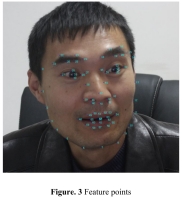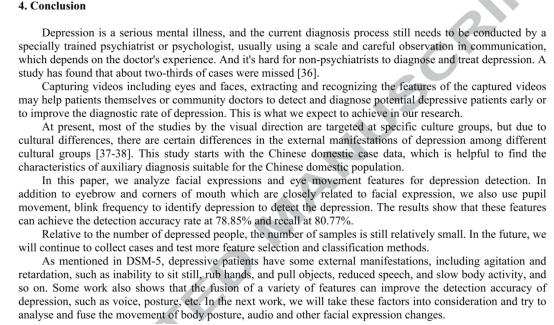文献精读报告
文献信息:题目——发表期刊/会议名称——发表年份;
Facial Expression Video Analysis for Depression Detection in Chinese Patients--J. Vis. Commun. Image R.-- 2018
1. 摘要内容是什么?(要理解人家如何写摘要的)
Abstract: Emotional state analysis of facial expression is an important research content of emotion recognition. At the same time, in the medical field, the auxiliary early screening tools for depression are also urgently needed by clinics. Whether there are differences in facial expression changes between depressive patients and normal people in the same situation, and whether the characteristics can be obtained and recognized from the video images of depressive patients, so as to help doctors detect and diagnose potential depressive patients early are the contents of this study. In this paper, we introduce the videos collection process of depression patients and control group at Shandong Mental Health Center in China. The key facial features are extracted from the collected facial videos by person specific active appearance model. On the basis of locating facial features, we classified depression with the movement changes of eyes, eyebrows and corners of mouth by support vector machine. The results show that these features are effective for automatic classification of depression patients.
Keywords: Depression Detection; Facial Expression; Video Processing; Eye Movement; Feature Extraction
摘要简述:面部识别是表情识别的一个重要内容,现在急需一个早期筛查抑郁症的辅助工具。本次课题主要研究正常人和抑郁者之间的面部表达是否有区别,这种特征能否被检测出来,是否能作为医生的辅助工具。本论文介绍了如何收集数据,如何提取特征值。我们用支持向量机以及眼睛、眉毛、嘴角等特征值进行分类。
2. 拟解决的问题(Motivation)
A large number of literatures have studied depressive disorders in neuroanatomy, endocrinology, and physiology, but there are no methods that can be used as a diagnostic tool for depression, as mentioned in DSM-5 [2].
尽管神经解剖学、内分泌学和生理学对抑郁症进行了很多的研究,但是DSM-5说明这些方法不足以作为诊断工具。
3. 解决方法(Method)
实验者被分为3组,第一组收集基本的面部信息,第二组回答问题,第三组观看情绪图片,临床医生在电脑屏幕上展示了一种中性表情和六种基本表情(包括悲伤、厌恶、恐惧、惊讶、愤怒和快乐),并要求参与者模仿他们的中性表情和基本面部表情。根据FACS编码系统从面部挑选几个点(眼睛,眉毛,嘴巴),利用这些特征对分类器进行分类。用人工标记实验者面部的68个点(这些点在Xm2vts[33]额脸数据中定义),如Figure.3所示。对图像和标记点进行AAM(Active Appearance Model主动外观模型)训练

使用Viola-Jones 面部检测去检测面部区域。用于初始化AAM,然后用使用AAM的等式1来得到特征点的位置。

选择面部表情和眼睛特征点检测抑郁,包括瞳孔运动、眨眼频率、双侧眉毛和嘴角运动变化。
利用上述距离的最大值、最小值和标准差来测量面部表情变化的程度。同时,为了消除不同面部之间的差异以及由于距离相机的距离而引起的投影差异,我们将最大、最小和标准差的距离值除以平均距离。
我们希望确定参与者是否抑郁。根据所选择的特征对参与者进行分类,是一个二值分类问题。本文利用支持向量机对特征向量进行分类。SVM分类器采用径向基函数(RBF),采用林智仁的Libsvm工具[35]进行参数优化。

5. 实验结果及分析 (Results)


6. 总结/结论(Conclusions)

7. 还存在什么问题(Inspirations)
As mentioned in DSM-5, depressive patients have some external manifestations, including agitation and retardation, such as inability to sit still, rub hands, and pull objects, reduced speech, and slow body activity, and so on. Some work also shows that the fusion of a variety of features can improve the detection accuracy of depression, such as voice, posture, etc. In the next work, we will take these factors into consideration and try to analyse and fuse the movement of body posture, audio and other facial expression changes.
8. 写作有什么特点:
8.1文章的整个结构包含那几个部分?
1.题目
2.作者
3.摘要
4.引言
5.方法论
6.结果
7.总结
8.致谢
9.参考文献
8.2引言(Introduction)撰写如何组织的?(找出“引言”中每一段话的中心句,或自己总结出中心句)
第1段: 抑郁症的严重性,中国目前已有大量的病例
第2段: 目前的诊断手段严重依赖医生的经验,急需一种辅助工具
第3 段:一个直接高精度对象分析方法仍然是跨医学和跨学科的重点
第4段:从面部表达和行为分析来进行诊断是有可能的
第5段:视频面部分析抑郁症是一个重要的研究内容,抑郁症患者在不同的环境下面部表达是否异于常人、是否能从视频中检测是一个重要的研究内容。
第6段:情感计算是一个高度集成的技术领域
第7段:Jeffrey F. Cohn研究了面部移动抑郁识别的可能性。结果精确度可以实现的很高
第8段:有许多工作集中针对精确表达和眼神特征。scherer发现抑郁者笑的很少,Girard发现他们极少皱眉但是嘴巴会很紧张。
8.3有什么语言表达优美的好句子可以摘录下来,供以后写作借鉴?例如,如何看“图”说话、看“表”说话、如何描述不同方法的性能高低和比较,如何表述因果关系。。。。等等。(摘录2-4个好句子)
好句子复制过来即可(不能截图)。
The pictures were selected from the International Affective Picture Library which was divided into positive emotional pictures, neutral emotional pictures and negative emotional pictures according to their grade.
The feature points of these facial images of the participations were artificial marked with 68 points which were defined in Xm2vts [33] frontal face data, as shown in figure 3.
Facial expressions and eyes feature points are selected to detect the depression, including eye pupil movement, blinking frequency, and movement changes of bilateral eyebrows and corners of mouth.



